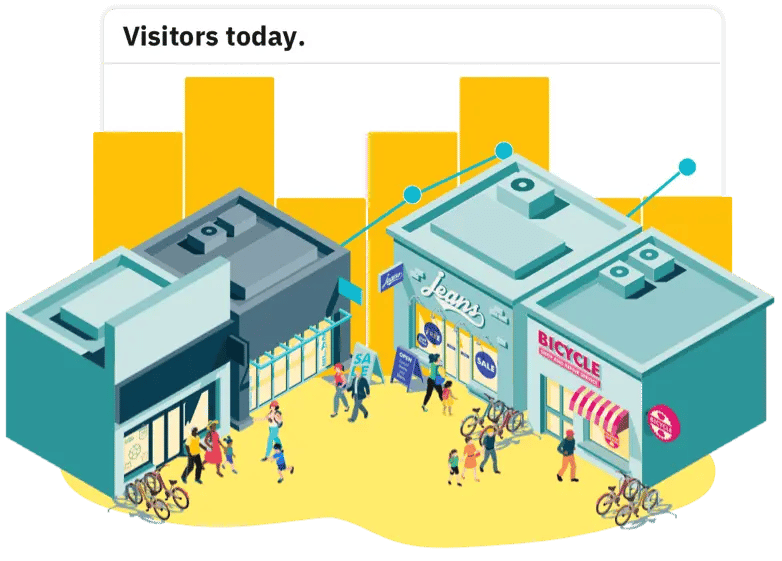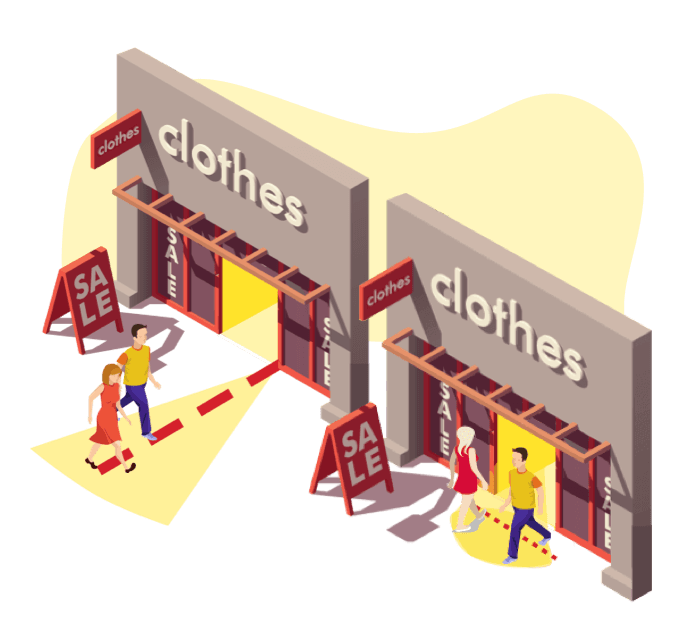In retail, footfall-related metrics have become cornerstone data points used to track various aspects of store performance. Everything from RoI of marketing spend, to staffing requirements and, of course, in-store conversion rates.
That being said, after having hundreds of customer conversations, we’ve noticed a trend: based on systems they've used in the past, many retailers have trouble trusting the data, specifically due to problems with accuracy. Ultimately, these fears almost always end up with a lot of value being left on the table.
As this seems to come up frequently, we thought it would be useful to write an article detailing the accuracy expectations across a range of different people counting technologies.
It’s worth bearing in mind that different technologies are useful for different applications. However, shining a light on where inaccuracies lie can help you interpret your people count data, or assist in choosing which technology most suits your current application.
In the following section, we will discuss the commonly available technologies, describing how they work, and what will cause them to fail.
Mobile phone tracking
This technology ‘sniffs’ out mobile phones by sending wireless signals within their detection range, and infers a count number based on this. There was some hope for this approach in the mid- 2010s, as smartphones became ubiquitous, and ‘big data’ was the buzzword du jour.
However, the tide has receded for this approach, as fundamental barriers have not been overcome, including sample variances (e.g. some people have two phones), MAC address randomization which can make one phone appear as multiple phones over time - and proximity detection problems - where the technology cannot distinguish between someone just inside or outside a doorway.
As such, this method is useful for a specific set of circumstances, such as in gaining a broad understanding of visitor paths in a very large area - but is not appropriate to collect data on a specific number of store visitors, or for use in conversion rate calculations.

Beam counters
This type of counter uses a beam of infrared light pointed at a receiver or reflector, counting crossings whenever the beam is broken. Their main advantage is that they tend to be very cheap. They can also be battery-powered and usually allow for quick and easy set-up.
Unfortunately though, in almost all cases, they have very low accuracy. These inaccuracies are in general caused by fundamental flaws in the crossing detection method. As count is measured whenever the beam is broken, people passing through the beam side by side or in a group will often be undercounted.
On the other hand, if someone walks in and out of the doorway multiple times in a short period, or if something other than a person breaks the beam, again these counters will lose accuracy. In addition to this, they're difficult to audit, monodirectional, and need to be placed in a location where you'll be able to also mount a reflector/receiver.
Optical cameras
Optical counters come in all shapes and sizes - from monocular to stereo, depth-sensing, or thermal. They are the most accurate category of sensors by far and can be used for indoor or outdoor counting purposes.
Thermal
Thermal counters use an infrared camera to capture a heatmap of their environment. One of their main advantages is that, as they're not capturing visible light, they are naturally GDPR compliant. They also work well at any light level however, during regular retail business hours, this is rarely utilized. A number of factors can affect their accuracy, for example, heat-reflective surfaces can mask people from the view of the camera, and the video they produce is more difficult to audit.
Stereo
Stereo counters are popular and work by detecting depth much like humans can, and do a good job in distinguishing between a human and, say, a bag. That being said, they do tend to be expensive and complex to install, but they generally provide a good accurate count if installed correctly.
Monocular
Monocular cameras in the past have suffered from many accuracy problems- they are built to count any object that moves beneath them - which can set off a count even if it’s not a person. For example, a pram, or large bag, could be counted. Furthermore, the early simplistic tracking algorithms resulted in miscounts or multiple counts of people, as unusual movements or dwelling triggered the count.
These days though, the issues with monocular cameras have been solved by the recent advances in machine learning and computer vision algorithms. The latest algorithms coupled with good hardware can overcome almost any environmental or behavioral issues. At HoxtonAi, we retrain our algorithms almost every week, to ensure the highest data quality across our client base, which means we don’t need expensive dual-camera setups to achieve high accuracy rates.

Recent Articles
How real-time footfall data helped a Telco Franchisee drive a 20% increase in revenue
Duncan Mann | Oct 2024
Background: the importance of sales conversion rate
Read moreCase Study: How fashion retailer GOOD uses the HoxtonAi Retail Report to improve accountability and increase conversion across their stores.
Owen | Jun 2023
“The retail report has been a game-changer. Each week, we discuss the footfall and conversion ...
Read moreOn the accuracy of retail footfall counters
Owen | May 2023
In retail, footfall-related metrics have become cornerstone data points used to track various ...
Read moreThe OKR goal setting framework: how to drive success in retail
Owen | Apr 2023
At HoxtonAi, we speak to hundreds of retailers about their store management, data requirements and ...
Read moreHow combining different types of footfall data can build a digital view of physical stores
Owen | Apr 2023
One of the biggest differences between optimization in online and physical retail spaces is the ...
Read moreWhy footfall isn't the end-all. What to do about the retail data gap.
Owen | Apr 2023
In our experience, we’ve found that most retailers are familiar with the idea of monitoring ...
Read moreThe Main Challenges for Retailers in Fully Leveraging Footfall Data
Owen | Mar 2023
In today's digital age, data has become a valuable asset for businesses looking to optimize their ...
Read moreWhat We Talk About When We Talk About Retail Footfall
Owen | Mar 2023
The soft side of cold, hard data We’ve released content on the ‘hard’ aspects of using data to ...
Read moreTop 6 Essential KPIs & Metrics in Retail
Owen | Mar 2023
As retail technology has evolved, we have found better ways to measure, track and compare ...
Read moreWhat is Conversion in Retail? And How to Measure it in a Physical Store?
Owen | Mar 2023
What is a conversion rate? A conversion rate is typically considered to be the percentage of people ...
Read moreHow to use Footfall Analytics to Improve Store Performance
Duncan Mann | Mar 2023
Before we get started, for a quick reminder of what 'people count' and 'footfall' mean, check out ...
Read moreWhat We've Found Analysing Footfall Data in Retail
Duncan Mann | Mar 2023
5 Trends We've Noticed... "At HoxtonAi, we work with customers to ensure their data is high ...
Read moreClosing the data gap between online and physical retailing
Owen | Mar 2023
As shoppers continue to return to the high street post-pandemic, physical stores need to catch up ...
Read moreAn Introduction to People Counting in Retail
Owen | Mar 2023
What is people counting? Simply put, people counting is the act of counting the number of people ...
Read moreCase Study: How Center Parcs Use Occupancy Data To Drive Better Guest Experiences.
Duncan Mann | Aug 2022
We initially trialled the HoxtonAi solution on a small scale to ‘kick the tyres’ and see if it’s a ...
Read more